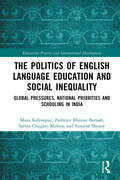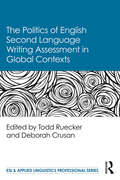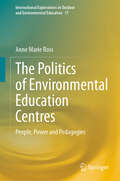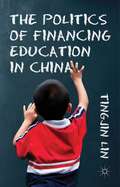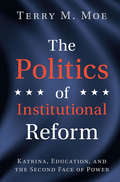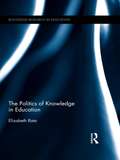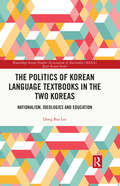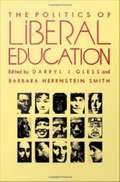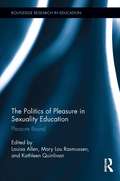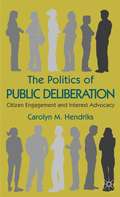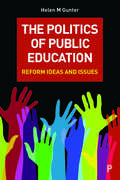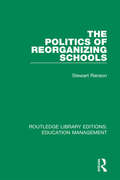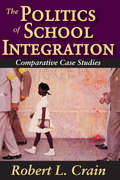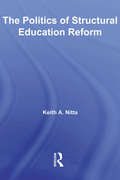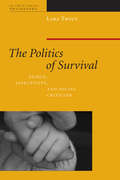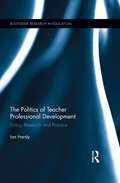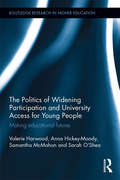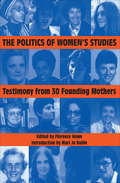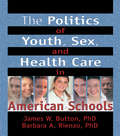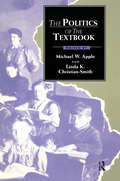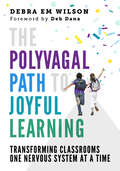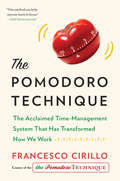- Table View
- List View
The Politics of English Language Education and Social Inequality: Global Pressures, National Priorities and Schooling in India (Education, Poverty and International Development)
by Maya Kalyanpur Padmini Bhuyan Boruah Sarina Chugani Molina Sunaina ShenoyBased on policy analysis and empirical data, this book examines the problematic consequences of colonial legacies of language policies and English language education in the multilingual contexts of the Global South. Using a postcolonial lens, the volume explores the raciolinguistics of language hierarchies that results in students from low-income backgrounds losing their mother tongues without acquiring academic fluency in English. Using findings from five major research projects, the book analyzes the specific context of India, where ambiguous language policies have led to uneasy tensions between the colonial language of English, national and state languages, and students’ linguistic diversity is mistaken for cognitive deficits when English is the medium of instruction in schools. The authors situate their own professional and personal experiences in their efforts at dismantling postcolonial structures through reflective practice as teacher educators, and present solutions of decolonial resistance to linguistic hierarchies that include critical pedagogical alternatives to bilingual education and opportunities for increased teacher agency. Ultimately, this timely volume will appeal to researchers, scholars, academics, and students in the fields of international and comparative education, English and literacy studies, and language arts more broadly. Those interested in English language learning in low-income countries specifically will also find this book to be of benefit to their research.
The Politics of English Second Language Writing Assessment in Global Contexts (ESL & Applied Linguistics Professional Series)
by Todd Ruecker Deborah CrusanReflecting the internationalization of the field of second language writing, this book focuses on political aspects and pedagogical issues of writing instruction and testing in a global context. High-stakes assessment impacts the lives of second language (L2) writers and their teachers around the world, be it the College English Test in China, Common Core-aligned assessments in the U.S., English proficiency tests in Poland, or the material conditions (such as access to technology, training, and other resources) affecting a classroom. With contributions from authors working in ten different countries in a variety of institutional contexts, the chapters examine the uses and abuses of various writing-related assessments, and the policies that determine their form and use. Representing a diverse range of contexts, methods, and disciplines, the authors jointly call for more equitable testing systems that consider the socioeconomic, psychometric, affective, institutional, and needs of all students who strive to gain access to education and employment opportunities related to English language proficiency.
The Politics of Environmental Education Centres: People, Power and Pedagogies (International Explorations in Outdoor and Environmental Education #17)
by Anne Marie RossThis book juxtaposes a representation of environmental education centres around the globe with centres within the New South Wales Department of Education in Australia. As terminology shifted from nature study and conservation education to environmental education then “environmental and sustainability education” within “sustainable development” the centres embodied and encompassed this evolution. The book traces the centres’ journeys through the phenomenon of the 1970s growth in socially conscious governance, to 1980s-1990s public managerialism, to the tightening tentacles of capitalism. The complexity of education as a socio-political endeavour is made explicit. Themes including the changing dynamics of caring for the environment, and bureaucratic and political manoeuvring, in addition to the effects of activism and globalisation are viewed through a centre lens as the centres survive and thrive in ever increasing neoliberal times. The book will appeal to teachers, academics and bureaucrats interested in the history and politics of environmental education.
The Politics of Financing Education in China
by Tingjin LinTingjin Lin explores the conflict between self-interest and the provision of equality of opportunity facing educators in China. Provincial leaders prove reluctant to equalize education when doing so means sacrificing their future promotion.
The Politics of Institutional Reform: Katrina, Education, and the Second Face of Power
by Terry M. MoeIn this ground breaking analysis, Terry Moe treats Hurricane Katrina as a natural experiment that offers a rare opportunity to learn about the role of power in the politics of institutional reform. When Katrina hit, it physically destroyed New Orleans' school buildings, but it also destroyed the vested-interest power that had protected the city's abysmal education system from major reform. With the constraints of power lifted, decision makers who had been incremental problem-solvers turned into revolutionaries, creating the most innovative school system in the entire country. The story of New Orleans' path from failure to revolution is fascinating, but, more importantly, it reveals the true role of power, whose full effects normally cannot be observed, because power has a 'second face' that is hidden and unobservable. Making use of Katrina's analytic leverage, Moe pulls back the curtain to show that this “second face” has profound consequences that stifle and undermine society's efforts to fix failing institutions.
The Politics of Knowledge in Education (Routledge Research in Education)
by Elizabeth RataThis book explores the decline of the teaching of epistemic, conceptual knowledge in schools, its replacement with everyday social knowledge, and its relation to changes in the division of labor within the global economy. It argues that the emphasis on social knowledge in postmodern and social constructionist pedagogy compounds the problem, and examines the consequences of these changes for educational opportunity and democracy itself.
The Politics of Korean Language Textbooks in the Two Koreas: Nationalism, Ideologies and Education (Routledge/Asian Studies Association of Australia (ASAA) East Asian Series)
by Dong Bae LeeThis book investigates the politics embedded in the Korean-language textbooks utilised between 1895 and 2019, within the context of one Korea (pre-colonial and colonial eras), the divided Koreas, and an ethnic Korean group residing in Japan (Chongryon). By analysing the inclusions and omissions from Korean-language the author successfully highlights the impact of Korean politics, making clear how rulers have attempted to control their citizens and legitimize their rule by using primary school Korean-language textbooks as a medium for political education and inculcation. It succinctly displays how different visions of ‘ideal citizenship’ have been presented in Korea and traces the resulting shift in views towards neighbouring nations as a result, identifying how different rival countries were demonized at different times. This chapter also shows some consistent omissions, such as the lower classes and marginalized individuals within their respective nations. Presenting recommendations for potential improvements of the content of future textbooks this study will be of interest to students of Asian Studies, Post-colonial Studies, Critical Curriculum Studies, Critical Discourse Studies, and Korean Studies.
The Politics of Liberal Education
by Barbara Herrnstein Smith Darryl J. GlessControversy over what role "the great books" should play in college curricula and questions about who defines "the literary canon" are at the forefront of debates in higher education. The Politics of Liberal Education enters this discussion with a sophisticated defense of educational reform in response to attacks by academic traditionalists. The authors here--themselves distinguished scholars and educators--share the belief that American schools, colleges, and universities can do a far better job of educating the nation's increasingly diverse population and that the liberal arts must play a central role in providing students with the resources they need to meet the challenges of a rapidly changing world. Within this area of consensus, however, the contributors display a wide range of approaches, illuminating the issues from the perspectives of their particular disciplines--classics, education, English, history, and philosophy, among others--and their individual experiences as teachers. Among the topics they discuss are canon-formation in the ancient world, the idea of a "common culture," and the educational implications of such social movements as feminism, technological changes including computers and television, and intellectual developments such as "theory. " Readers interested in the controversies over American education will find this volume an informed alternative to sensationalized treatments of these issues. Contributors. Stanley Fish, Phyllis Franklin, Henry Louis Gates Jr. , Henry A. Giroux, Darryl J. Gless, Gerald Graff, Barbara Herrnstein Smith, George A. Kennedy, Bruce Kuklick, Richard A. Lanham, Elizabeth Kamarck Minnich, Alexander Nehamas, Mary Louise Pratt, Richard Rorty, Eve Kosofsky Sedgwick
The Politics of Performance Funding for Higher Education: Origins, Discontinuations, and Transformations
by Kevin J. Dougherty Rebecca S. NatowThe first nation-wide analysis of the politics of performance funding in higher education.Performance funding ties state support of colleges and universities directly to institutional performance on specific outcomes, including retention, number of credits accrued, graduation, and job placement. The theory is that introducing market-like forces will prod institutions to become more efficient and effective. In The Politics of Performance Funding for Higher Education, Kevin J. Dougherty and Rebecca S. Natow explore the sometimes puzzling evolution of this mode of funding higher education. Drawing on an eight-state study of performance funding in Florida, Illinois, Indiana, Missouri, Ohio, South Carolina, Tennessee, and Washington, Dougherty and Natow shed light on the social and political factors affecting the origins, evolution, and demise of these programs. Their findings uncover patterns of frequent adoption, discontinuation, and re-adoption.Of the thirty-six states that have ever adopted performance funding, two-thirds discontinued it, although many of those later re-adopted it. Even when performance funding programs persist over time, they can undergo considerable changes in both the amount of state funding and in the indicators used to allocate funding. Yet performance funding continues to attract interest from federal and state officials, state policy associations, and major foundations as a way of improving educational outcomes.The authors explore the various forces, actors, and motives behind the adoption, discontinuation, and transformation of performance funding programs. They compare U.S. programs to international models, and they gauge the likely future of performance funding, given the volatility of the political forces driving it. Aimed at educators, sociologists, political scientists, and policy makers, this book will be hailed as the definitive assessment of the origins and evolution of performance funding.
The Politics of Pleasure in Sexuality Education: Pleasure Bound (Routledge Research in Education)
by Louisa Allen Mary Lou Rasmussen Kathleen QuinlivanPleasure and desire have been important components of the vision for sexuality education for over 20 years. This book argues that there has been a lack of scrutiny over the political motivations that underpin research supportive of pleasure and desire within comprehensive sexuality education. In this volume, key researchers in the field consider how discourses related to pleasure and desire have been taken up internationally. They argue that sexuality education is clearly shaped by specific cultural and political contexts, and examine how these contexts have shaped the development of pleasure’s inclusion in such programs. Via such discussions, this volume incites a re-configuration of thought regarding sexuality education’s approach to pleasure and desire.
The Politics of Public Deliberation
by Carolyn M. HendriksThis ground breaking book provides empirical and theoretical insights into the interface between deliberative democracy and the rough and tumble of interest groups in advocacy politics. It examines how deliberative ideals work alongside the adversarial realties of interest-based politics.
The Politics of Public Education: Reform Ideas and Issues
by Helen M. GunterAt a time when public education and reform agendas are changing the way we approach education, this book critically examines the key issues facing the public with implications for education policy makers, professionals and researchers. Drawing on empirical evidence gathered over 20 years, Helen Gunter confronts current issues about social justice and segregation. She uses Arendtian ideas to help the reader to ‘think politically’ about education and how and why public services education can be reimagined for the future.
The Politics of Race, Class and Special Education: The selected works of Sally Tomlinson
by Sally TomlinsonIn the World Library of Educationalists series, international experts themselves compile career-long collections of what they judge to be their finest pieces – extracts from books, key articles, salient research findings, major theoretical and practical contributions – so the world can read them in a single manageable volume. Readers will be able to follow the themes and strands and see how their work contributes to the development of the field. Professor Sally Tomlinson brings together 12 of her key writings in one place, including chapters from her best-selling books and articles from leading journals. In this landmark publication she reviews and recounts the history and development of her research and writing over 30 years that is concerned with the politics of education systems, especially special education, and the place of social classes and ethnic and racial minorities in the systems. Social class, race and gender have historically always been essential markers in deciding who would receive a minimum or inferior education and thus fail to obtain whatever were currently acceptable qualifications. Definitions of the ‘less able’ or ineducable were based on beliefs in the biological and cultural inferiority of lower social classes, racial and immigrant groups. Professor Tomlinson’s aim in her work has always been to introduce sociological, historical and political perspectives into an area dominated by psychological, administrative and technical views and to explain how the individual ‘problems’ were connected to wider social structures and policies. This unique collection illustrates the development of Professor Tomlinson’s thinking over the course of her long and esteemed career.
The Politics of Reorganizing Schools (Routledge Library Editions: Education Management #20)
by Stewart RansonOriginally published in 1990. The rapid decline in the birth rate in the 1970s and the resulting fall in school rolls had a dramatic effect on the curriculum, staffing, organization and management of schools. This book focuses on the national and local politics surrounding school closures, amalgamations and the replacement of sixth forms with tertiary colleges. The author illuminates the changing politics of education through an analysis based on research in LEAs including Birmingham and Manchester. He explores the roles of central government, local education authorities and the politics of increased parental choice. The book shows how spare capacity in schools captures the political struggle between those concerned to protect the post-war tradition of educational opportunity for all and the New Right who want to seize the chance to place schools in the market place, expanding consumer choice and public accountability.
The Politics of School Integration: Comparative Case Studies
by Robert CrainThis book discusses desegregation as a community decision, focusing on case studies from the 1960s. Crain uses comparative techniques based on fifteen northern and southern cities. The author seeks a "total" explanation for the decision to desegregate by determining its proximate causes and locating the roots of the decision in the economic, social, and political structure of the community. This work represents the first attempt to conduct a genuinely scientific analysis of the political process by which school systems were desegregated in this period.Robert L. Crain documents the way in which eight non-southern, big-city school systems met community demands to reduce segregation. Reactions varied from immediate compliance to months and years of stubborn resistance, some cities maintaining good relations with civil rights leaders and others becoming battlegrounds. Differences in these reactions are explained and focus is brought to desegregation in the South New Orleans in particular. The situation there is contrasted with six peacefully desegregated southern cities as well as the attitude of its powerful economic elite. The concluding part of the book is a general consideration of the civil rights movement in the cities studied, and the author considers the implications of his findings, both for the future of school desegregation and for studies of community politics.Employing comparative techniques and concentrating upon the outputs of political systems, this is a highly innovative contribution to the study of community power structures and their relationship to educational systems. It remains an effective supplement to courses in sociology, political science, and education, as well as an important source of data for everyone concerned with the history of efforts for national integration.
The Politics of Structural Education Reform (Routledge Research in Education #Vol. 13)
by Keith A. NittaEducation policymaking is traditionally seen as a domestic political process. The job of deciding where students will be educated, what they will be taught, who will teach them, and how it will be paid for clearly rests with some mix of district, state, and national policymakers. This book seeks to show how global trends have produced similar changes to very different educational systems in the United States and Japan. Despite different historical development, social norms, and institutional structures, the U.S. and Japanese education systems have been restructured over the past dozen years, not just incrementally but in ways that have transformed traditional power arrangements. Based on 124 interviews, this book examines two restructuring episodes in U.S. education and two restructuring episodes in Japanese education. The four episodes reveal a similar politics of structural education reform that is driven by symbolic action and bureaucratic turf wars, which has ultimately hindered educational improvement in both countries.
The Politics of Survival: Peirce, Affectivity, and Social Criticism (American Philosophy)
by Lara TroutHow can sincere, well-meaning people unintentionally perpetuate discrimination based on race, sex, sexuality, or other socio-political factors? To address this question, Lara Trout engages a neglected dimension of Charles S. Peirce's philosophy - human embodiment - in order to highlight the compatibility between Peirce's ideas and contemporary work in social criticism. This compatibility, which has been neglected in both Peircean and social criticism scholarship, emerges when the body is fore-grounded among the affective dimensions of Peirce's philosophy (including feeling, emotion, belief, doubt, instinct, and habit). Trout explains unintentional discrimination by situating Peircean affectivity within a post-Darwinian context, using the work of contemporary neuroscientist Antonio Damasio to facilitate this contextual move. Since children are vulnerable, naïve, and dependent upon their caretakers for survival, they must trust their caretaker's testimony about reality. This dependency, coupled with societal norms that reinforce historically dominant perspectives (such as being heterosexual, male, middle-class, and/or white), fosters the internalization of discriminatory habits that function non-consciously in adulthood. The Politics of Survival brings Peirce and social criticism into conversation. On the one hand, Peircean cognition, epistemology, phenomenology, and metaphysics dovetail with social critical insights into the inter-relationships among body and mind, emotion and reason, self and society. Moreover, Peirce's epistemological ideal of an infinitely inclusive community of inquiry into knowledge and reality implies a repudiation of exclusionary prejudice. On the other hand, work in feminism and race theory illustrates how the application of Peirce's infinitely inclusive communal ideal can be undermined by non-conscious habits of exclusion internalized in childhood by members belonging to historically dominant groups, such as the economically privileged, heterosexuals, men, and whites. Trout offers a Peircean response to this application problem that both acknowledges the "blind spots" of non-conscious discrimination and recommends a communally situated network of remedies including agapic love, critical common-sensism, scientific method, and self-control.
The Politics of Teacher Professional Development: Policy, Research and Practice (Routledge Research in Education #80)
by Ian HardyThe Politics of Teacher Professional Development: Policy, Research and Practice provides innovative insights into teachers’ continuing development and learning in contemporary western contexts. Rather than providing a list of "how-tos" and "must dos," this volume is premised on the understanding that by learning more about the current conditions under which teachers and other educators work and learn, it is possible to understand, and consequently improve, the learning opportunities teachers experience. Teacher professional development is not simply construed as an isolated series of events, such as day-long workshops marking the beginning of each school year or term, or individualistic "one-off" activities focused on new teaching approaches, curricula or assessment strategies. Rather, through application of sociologist Pierre Bourdieu’s understanding of social practices as contested, teacher professional development is revealed as a complex social practice which exists as policy, as a research product and process, and as an important part of teachers’ work. The book reveals how PD as policy, research and teachers’ work are inherently contested. An extended series of case studies of teacher professional development practices from Canada, England and Australia are employed to show how these tensions play out in complex ways in policy and practice.
The Politics of Widening Participation and University Access for Young People: Making educational futures (Routledge Research in Higher Education)
by Sarah O'Shea Samantha McMahon Anna Hickey-Moody Valerie HarwoodYoung people with tenuous relationships to schooling and education are an enduring challenge when it comes to addressing social inclusion, yet their experiences remain overlooked in efforts to widen participation in higher education. The Politics of Widening Participation and University Access for Young People examines the existing knowledges and feelings these young people have about higher education, and, through the authors’ empirical research, demonstrates how sustained connections to educational futures can be created for them. Drawing from an empirical study with nearly three hundred young people who have precarious relationships to schooling and live in disadvantaged communities, this book offers new insights into their subjects’ experiences of educational disadvantages. It explains the different ways the university is constructed as impossible, undesirable, or even risky, by young people experiencing educational disadvantage. The book brings their stories into focus to offer new ways of thinking about the educational consequences of alienation from school. It shows how our understanding of the politics of experience of these young people has an important impact on our ability to develop appropriate means through which to engage them in higher education. This book challenges and significantly advances the popular frames for international debate on widening participation and the ethical right to educational participation in contemporary society. As such, it will be of be of key interest to academics, researchers and postgraduate students in the fields of higher education, sociology of education, anthropology of education, cultural studies of education, sociology as well as to those concerned by the impact of disadvantage on young people’s understandings of, and aspirations towards, education and attending university.
The Politics of Women's Studies: Testimony from 30 Founding Mothers (The\women's Studies History Ser.)
by Edited by Florence Howe and Introduction by Mari Jo BuhleThe true stories of those bold women who espoused feminism in the world of academia and forever changed our educational system and culture. In the patriarchal halls of 1970s academe, women who spoke their minds risked their careers. Yet intrepid women—students, faculty, administrators, members of the community—persisted in collaborating on women&’s studies programs. In doing so, they created a movement that altered paradigms, curricula, teaching styles, and content across disciplines. In these original essays &“we hear the voices of feminists exhilarated by the opportunities and challenges of creating women&’s studies programs in American colleges and universities, nurtured by the women&’s movement of the 1970s,&” from young graduate students and newly hired faculty to tenured professors in search of ways to improve their students&’ capacities to learn, veteran academics at last witnessing change, and even a few administrators (Library Journal). In all of these programs, these &“founding mothers&” grappled not only with issues of gender, but with those of class, race, and sexuality in a decade infused with political unrest and questioning, when civil rights and anti-war activism, as well as feminism, shaped academic worlds.
The Politics of Youth, Sex, and Health Care in American Schools
by Marvin D Feit Barbara A RienzoExamine school-based health clinics and the political considerations and strategies that can help them succeed!The Politics of Youth, Sex, and Health Care in American Schools reveals the history and political dynamics involved in building and sustaining an important innovation in the way health care services are delivered to America’s youth: the school-based health clinic. These clinics provide vital health services--including crucial yet controversial reproductive services--to youth. In addition to analyzing the nature and extent of the political barriers facing school-based clinics, this vital book describes the strategies that have proven most effective in overcoming them.This essential book begins with an overview of the existing literature on the history and provision of health care for youth. Then it presents the results of a study that utilized a two-pronged approach: a nationwide survey of clinic administrators (supplemented with aggregate data) and intensive case studies of five representative locales. By combining the quantitative data from the national survey with the more qualitative information gleaned from the case study field work, The Politics of Youth, Sex, and Health Care in American Schools can deliver broad yet accurate generalizations as well as detailed interpretation of the authors’findings.This informative and insightful volume explores: the ways that school-based health clinics (SBHCs) have evolved, confronted opposition, and grown day-to-day issues that SBHCs face, including inadequate funding, lack of parental involvement, unsupportive teachers and schools, staffing/training issues, cultural issues, and more sources of opposition to SBHCs, including fundamentalist Protestants, Black Evangelicals, Catholics, and conservative parent groups ways to establish successful school health care reforms issues and recommendations for SBHCs in the futureTo date, there have been very few empirical studies of the politics of school health or of the provision of sexuality-related health services for youth. The greatest depth and breadth of information you can find on the subject is here, in The Politics of Youth, Sex, and Health Care in American Schools.
The Politics of the Textbook
by Michael W. Apple Linda K. Christian-SmithFirst Published in 1991. Routledge is an imprint of Taylor & Francis, an informa company.
The Politics, Practices, and Possibilities of Migrant Children Schools in Contemporary China
by Min YuThis book examines the dynamics surrounding the education of children in the unofficial schools of China s urban migrant communities. This ethnographic study focuses on both the complex structural factors impacting the education of children attending unofficial migrant children schools and the personal experiences of individuals working within these communities. As the book illustrates in careful detail, the migrant children schools serve a critical function in the community by serving as a hub for organized collective action around shared grievances related to issues of education, employment, well-being, and other social rights. In turn, the development of a collective identity among teachers, students, parents, and other members in the migrant communities makes it possible for activists to begin to work to address multiple forms of discrimination and maltreatment while simultaneously moving towards the possibility of more profound social transformation. "
The Polyvagal Path to Joyful Learning: Transforming Classrooms One Nervous System at a Time
by Debra Em WilsonThe optimal state for learning is one of safety, connection, motivation, and engagement. Every student and teacher is different, but there’s one thing each has in common: a responsive nervous system ready for action. Whether it’s a fight breaking out on the playground, a difficult conversation with a parent, or an impromptu fire drill, understanding how the nervous system responds can help keep teachers and students on an even keel. Polyvagal Theory (PVT) has had a tremendous impact on the mental health field, shedding light on how the nervous system predictably moves between different states in response to changing situations. School consultant Debra Em Wilson introduces PVT to educators and shows how using PVT-guided strategies can help create optimal learning environments. When school staff understand the role of the nervous system in learning, they can better help students develop the skills leading to increased resilience, adaptability, and flexibility: essential qualities for social, emotional, and academic success.
The Pomodoro Technique: The Acclaimed Time-Management System That Has Transformed How We Work
by Francesco CirilloAvailable through bookstores for the first time, the internationally acclaimed time management system that has been used by millions, written by Francesco Cirillo, creator of the Pomodoro Technique. Francesco Cirillo developed his famed system for improving productivity as a college student thirty years ago. Using a kitchen timer shaped like a pomodoro (Italian for tomato), Cirillo divided the time he spent working on a project into 25-minute intervals, with 5-minute breaks in between, in order to get more done, without interruptions. By grouping a number of pomodoros together, users can tackle a project of any length, and drastically improve their productivity, enhance their focus, and better achieve their goals. Originally self-published, and shared virally online, this new publication of The Pomodoro Technique includes several new chapters on how teams can use the pomodoro method to save time and increase productivity. The process underlying Cirillo’s technique includes five stages: planning the day’s tasks, tracking your efforts, recording your daily activities, processing what you have done, and visualizing areas for improvement. With this tried and tested method, readers can simplify their work, find out how much time and effort a task really requires, and improve their focus so they can get more done in the same amount of time each day.
